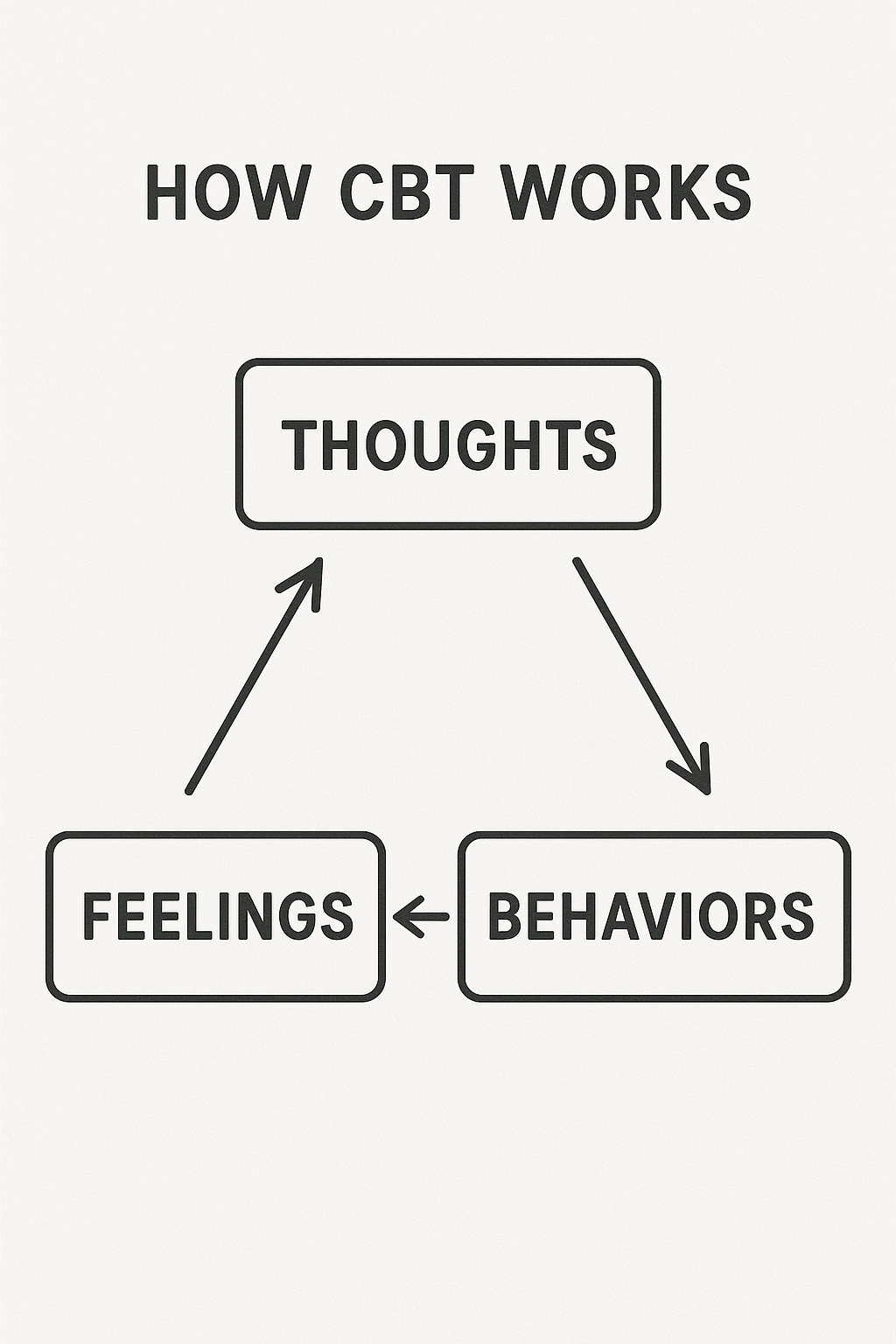What is Cognitive Behavioural Therapy? A Beginner's Guide
In a world facing a growing mental health crisis, more people than ever are searching for tools to manage anxiety, depression, and everyday stress. You may have seen that therapy is a great tool to use to help combat mental health crisis’s, but what is cognitive behavioural therapy? Cognitive Behavioural Therapy (CBT) is one of the most researched, practical, and accessible approaches out there — and it’s gaining attention for good reason.
In this beginner’s guide, you’ll learn what CBT is, how it works, and whether it might help you or someone you care about. We’ll explore the science, real-world techniques you can try at home, and even a few surprising insights rarely discussed online. Whether you’re curious, struggling, or just looking to understand your mind a little better — this is a great place to start.
What is Cognitive Behavioural Therapy?
CBT is a type of psychotherapy that helps people manage mental and emotional health problems by identifying and changing negative thinking and behavioral patterns.
Put simply, CBT is a type of talk therapy that helps you challenge negative thought patterns and build healthier habits.
It focuses on the interconnectedness of thoughts, feelings, and behaviors, and how they influence each other. CBT is a collaborative and goal-oriented approach used to address a wide range of issues, including anxiety, depression, and other mental and physical health conditions.
How CBT Works
CBT works by helping individuals identify and change negative or unhelpful thought patterns and behaviors that contribute to mental health challenges.
It focuses on the present and teaches practical skills to manage current problems by understanding the connection between thoughts, feelings, and actions.
Cognitive Behavioral Therapy (CBT) isn’t just talking about your feelings, it’s a structured, practical approach to rewiring your thinking and behavior. Here’s how the process typically works in therapy:

A Step-by-Step Walkthrough
Identify the Problem
The process begins by clearly defining the emotional or behavioral issue you’re struggling with—such as anxiety, low mood, or avoidance.Recognize Negative Thought Patterns
With guidance, you learn to observe and write down automatic thoughts that arise in triggering situations. These are often negative, unhelpful, or distorted.Evaluate and Challenge These Thoughts
You then examine whether these thoughts are realistic or biased. Are they based on facts or assumptions? Are there alternative ways of seeing the situation?Reframe with Balanced Thinking
Once the distortions are identified, you practice replacing them with more balanced, evidence-based thoughts. This helps reduce emotional intensity.Change Behavior Through Experiments
CBT includes behavioral strategies like exposure, activity scheduling, or problem-solving—testing out new ways of acting to break unhealthy patterns.Reinforce and Maintain Progress
Through repetition, reflection, and tools like journaling or thought records, you build mental habits that support long-term change.
What CBT Can Help With
CBT is used to treat a range of psychological problems including:
- Anxiety
- Social phobia, obsessive-compulsive disorder or post-traumatic stress disorder
- depression
- low self-esteem
- irrational fears
- hypochondria
- substance misuse, smoking, drinking or other drug use
- gambling problems
- eating disorders
- insomnia
- marriage or relationship problems
Meta-Cognition and the Power of Observing Your Thoughts
Meta-cognition is you ability to observe your thoughts without immediately reacting to them. This might sound subtle, but it can be life-changing.
Imagine you’re walking into a party and your brain says:
“No one here likes you”.
Instead of believing it instantly, CBT teaches you to pause and ask:
“Where did that thought come from? is it helpful or just an old habit?”
This moment of distance is called cognitive diffusion in Acceptance and Commitment Therapy. It’s not just about replacing negative thoughts, it’s about learning that you are not your thoughts.
Met-cognition gives you the power to respond, not just react.
Over time, this mental shift build emotional intelligence, resilience, and even self-compassion.

Does CBT Actually Work?
The Efficacy of Cognitive Behavioral Therapy reviewed 269 meta analytic studies and reviewed of those a representative sample of 106 meta-analyses examining CBT. This is a summary of what they found:
“The strongest support exists for CBT of anxiety disorders, somatoform disorders, bulimia, anger control problems, and general stress. Eleven studies compared response rates between CBT and other treatments or control conditions. CBT showed higher response rates than the comparison conditions in 7 of these reviews and only one review reported that CBT had lower response rates than comparison treatments. In general, the evidence-base of CBT is very strong.“
CBT can be used to help numerous individuals, however, unfortunately CBT won’t work for everyone or every psychological problem. I recommend, if you want to try it, do some research into how CBT has affected people in your position before to determine whether it will be the right fit for you.
How to Start CBT
If you want to give CBT a go, here are your most viable options:
- Seeing a licensed therapist
- Online therapy (e.g., BetterHelp, Headspace)
- CBT workbooks
If you want to learn more about psychology in general, here are some great book options to get you started -> Psychology Books
Quick Tips to Try CBT at Home
Start Thought Records
Thought records are records you make about your own thoughts after they happen. Think back to a triggering situation and write down the emotion and what sparked it. Then rate the emotion on a scale from 0-100%. Identify cognitive distortions and ask “what’s the evidence for and against this?”. Reframe it to a more balanced perspective than rank your emotions again.
Behavioral Activation
When we feel low, we stop doing things that once brought meaning or joy — which fuels the cycle of withdrawal. Behavioral Activation interrupts that.
Write a list of meaningful, pleasurable, or value-based activities.
Schedule them throughout your week, even in small doses.
Track your mood before and after each activity.
Use a CBT journal or App
Tracking your progress helps you notice patterns over time. Choose one:
Manual journaling (use templates or printed thought records)
Apps like Moodnotes, CBT Thought Diary, or Woebot (AI-based CBT coach)
Conclusion
There you have it, hopefully you now understand a little bit more about what Cognitive Behavioral Therapy is and how it could be beneficial for YOU.
You don’t need to be in crisis to start. And you don’t need a clinical background to benefit. Even small steps — like journaling your thoughts or challenging a limiting belief — can make a meaningful difference over time.
If this guide sparked something in you, consider trying one of the techniques today. CBT isn’t a quick fix, but it can be a powerful shift — and it all starts with curiosity and a willingness to look inward.
2 thoughts on “What is cognitive behavioural therapy? A Beginner’s Guide”
Sprunki Incredibox is a brilliant evolution of the original, adding fresh beats and visuals that elevate the music-mixing experience. If you love creativity and fun, check out their Shooting Games too!
That’s a great point about accessibility in shooters – so often overlooked! Thinking about streamlined onboarding, platforms like hm 88 download seem to prioritize user experience, making things easy even for new players. It’s a solid approach!